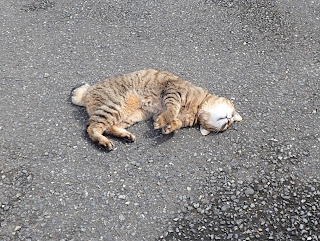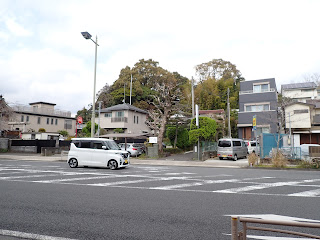 |
| Meow … |
We start walking Odawara Sogamae 箱根総構え from Hakone Itabashi Station 箱根板橋 for Hakone Tozan Train 箱根登山鉄道. The community around the Station is an old town. They have been defined as a suburb of Odawara City 小田原市 since the 1500s. Now the place consists of mainly houses and small businesses along National Route 1 国道1号線 entering Hakone Mountains 箱根. Before, this area was a farming community sat at the beginning of the water system providing water to the downtown from Hayakawa River 早川. Until in 1933 the modern system provides water to Odawara from Sakawa River System 酒匂川水系, Itabashi was a damned important community. Why did people switch the water source from Hayakawa River to Sakawa River? Well, modern life needed more water and the water of Lake Ashi 芦ノ湖, the main water source of Hayakawa, was to neighboring Shizuoka Prefecture 静岡県 (; my post on June 23, 2023). Hayakawa reached the limit at that time, you see? It is still a contentious issue between communities of Kanagawa and Shizuoka Prefectures ... Anyway, Hakone Itabashi was an area for water. That‘s the point for Odawara Sogamae fort.
 |
| Hakone Itabashi Station |
 |
| Near
Hakone Itabashi Station, there still is a water intake from Hayakawa River. |
 |
| But
the amount of flow for Hayakawa River is certainly too low for 190 thousand people of Odawara. I took this photo of the river from the water intake point. Water? Where is water? |
As a suburb, the community of Itabashi was outside of the defence system. But it had a large rice paddies spreading to the west. The successive warlords of Odawara Castle defined the area as the most outer layer of mort system. They sometimes built stone walls or small hills at the eastern hedge of rice paddies in Itabashi area. The structure was expected to act as a wall for downtown when artificial floods were activated over the paddies. The most well-preserved remains for such embankments near sea can be found in Odawara Castle Hayakawaguchi Gate 小田原城早川口. Until the end of the 16th century the place was the main gate to enter the Odawara Sogamae Fort when you came from the west. To go there, we leave Hakone Itabashi Station and walk a bit on Route 1 to the direction returning to Odawara Station. Find Itabashi-mitsuke 板橋見付 traffic light, and turn to the right at that crossing. The road enters an ordinary housing area going to the south. We simply follow the meandering road and eventually meet an old small tunnel going under Tokaido Line 東海道線. It is another historical structure. Proud engineers of more than 100 years ago built it during the 1910s in western style for then-the-most-advanced transportation technology called steam locomotive. Immediately before the tunnel on our left, there is a parking space which was demarked by a stone wall. The wall is one of the remains of Sogamae Mort. This means the place we stand was once rice paddies acted as mort when enemy forces advanced to Odawara Castle.
 |
| Turning left to enter residential area |
 |
| And here
is an ordinary looking parking lot with a cat. Could you see the stone wall? It’s a historical artifact. |
 |
| And the civil engineers of the early 20th
century surely utilized the medieval structure for their work. |
The
other side of the tunnel is the beginning of Route 135, the scenic (and always
congested) road runs along Sagami Bay reaching Shimoda City 下田 where in 1854 the first US
Consulate located. After finding Route 135, walk a bit to the south and cross
the first traffic light to the ocean side. From there it begins another
commuter road entering the housing area. Soon we find fairly well-built stone
walls on our left. The wall naturally enters the municipal garden which is the
remain of Odawara Castle Hayakawaguchi Gate. Archaeologists found the mort
structure here was double folded with firmly piled-up boulders harvested from nearby
remains of pyroclastic flow from Mt. Hakone. The height of the wall was more
than 2m high … Yeah, they were prepared for war, for sure.
 |
| And
here is the direction pole showing us the way to Hayakawaguchi Gate. |
 |
| In
no time, there is another stone wall. Come to think of it, they stands in this condition 500 years later. People built it so firmly. |
 |
| The
road we are walking now next to the stone wall was rice paddies once. |
Once upon a time, the stone walls continued to the seashore at the mouth of Hayakawa River. i.e. The Sogamae fort was using rice paddies along Hayakawa River, Hayakawa River, and the sea as mort to defend the city around Odawara Castle. In this regard, the downtown Odawara City facing Sagami Bay was treated exactly like commercial areas of European medieval walled city, and warlords were happy to protect commers’ area during the wars. Yeah, they were not fools. Who else could provide money for their troops? Even now, the structure of downtown Odawara keeps the characteristics for walled medieval community, but digging into the matter is a bit out of purpose for this forest blog. So, let us return to Itabashi-mitsuke traffic light next week. As the river and rice paddies, the owners of Odawara Castle fully utilized the geology, geography, and vegetation.
 |
| Returning
to Itabashi-mitsuke. The name of this crossing itself comes from the defense structure. More to it, next week. |
For enquires about sightseeing in Odawara City,
General Incorporated Association, Odawara Tourism
一般社団法人 小田原市観光協会
250-0042 350-1, Hagikubo, Odawara City
〒250-0042 小田原市荻窪350番地の1 小田原合同庁舎内2階
TEL:0465-20-4192
〒250-0042 小田原市荻窪350番地の1 小田原合同庁舎内2階
TEL:0465-20-4192
FAX:0465-20-4194



No comments:
Post a Comment